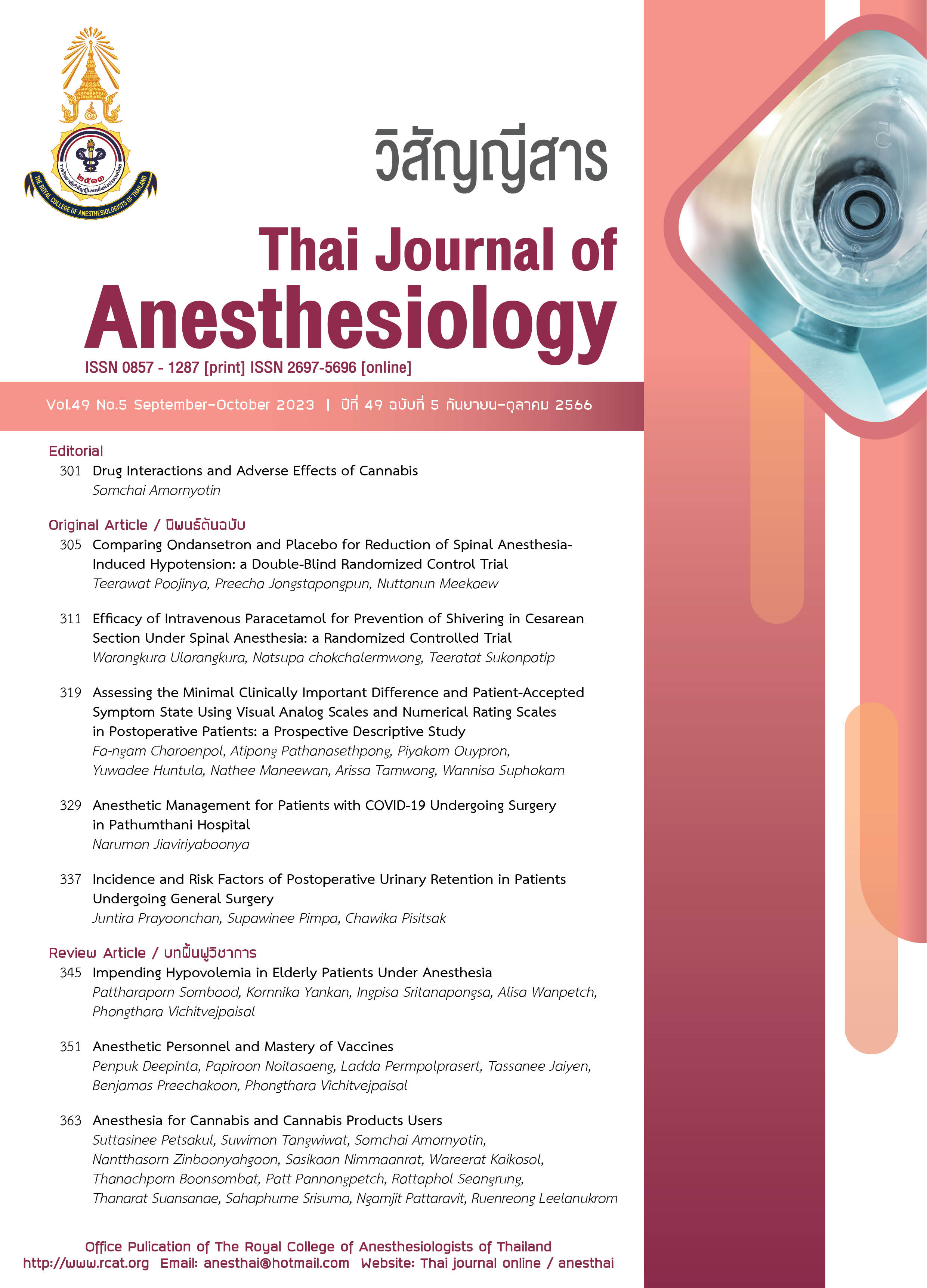ภาวะพร่องน้ำเหตุการณ์จวนตัวที่ยากจะหลีกเลี่ยงในผู้ป่วยสูงอายุ ที่มารับการระงับความรู้สึก
Main Article Content
บทคัดย่อ
น้ำในร่างกายมีความสำคัญต่อระบบการไหลเวียน กระบวนการชีวเคมี การควบคุมอุณหภูมิกาย และ เมตะบอลิซึมของเซลล์ ภาวะพร่องน้ำและเกลือแร่เป็นปัญหาที่พบบ่อยในผู้สูงอายุเนื่องจากความรู้สึก อยากดื่มน้ำถดถอยลงตามวัย จากโรคประจำตัวและผลข้างเคียงจากการใช้ยา สามารถนำไปสู่ภาวะแทรกซ้อนที่รุนแรง ทำให้อวัยวะสำคัญๆ ทำงานล้มเหลวและเสียชีวิตได้ ผู้ป่วยที่ต้องงดน้ำและอาหารก่อนการผ่าตัดควรได้รับสารน้ำทดแทน เพื่อช่วยพยุงพยาธิสรีรสภาพของร่างกายภายใต้การระงับความรู้สึกซึ่งสามารถกดกล้ามเนื้อหัวใจ ขยายหลอดเลือดและส่งผลให้ความดันเลือดลดต่ำลง จนทำให้เข้าใจผิดว่าผู้ป่วยมีภาวะพร่องสารน้ำ ในกรณีเช่นนี้อาจไม่มีความจำเป็นต้องให้สารน้ำทดแทน ควรพิจารณาให้เพียงยาตีบหลอดเลือดในผู้ป่วยที่เสียเลือดน้อยกว่าร้อยละ 20 ของปริมาณเลือดในร่างกาย เฝ้าระวังการเปลี่ยนแปลงของสัญญาณชีพ ปริมาณปัสสาวะและซีรั่มออสโมลาริตี้ อย่างไรก็ตามถ้าผู้ป่วยสูญเสียเลือดจำนวนมากควรพิจารณาให้สารน้ำหรือเลือดทดแทนอย่างเร่งด่วน พร้อมประเมินร่วมเพื่อเพิ่มความแม่นยำ ของระบบการไหลเวียนด้วยวิธีวัดแรงดันเลือดดำส่วนกลางหรือหลอดเลือดฝอยในปอด และภายหลังการผ่าตัดผู้ป่วยยังมีความจำเป็นต้องได้รับสารน้ำทางหลอดเลือดดำอย่างต่อเนื่องตามความเหมาะสมเพื่อขจัดยาระงับความรู้สึกส่วนเกิน ควบคู่ไปกับการดูแลประคับประคองในระบบอื่นๆ
Article Details

อนุญาตภายใต้เงื่อนไข Creative Commons Attribution-NonCommercial-NoDerivatives 4.0 International License.
เอกสารอ้างอิง
พาพิรุณ น้อยตาแสง, วราทิพย์ ทองเดช, สุภาณดี เจียรวิทยกิจ,
ปวณา ยนพันธ์, พงศ์ธารา วิจิตเวชไพศาล. สารทดแทนพลาสม่าเป็นผู้ช่วยเหลือในยามจําเป็นจริงหรือ. วารสารวิชาการราชวิทยาลัยจุฬาภรณ์. 2565;4:151-9.
Allison SP, Lobo DN. Fluid and electrolytes in the elderly. Curr Opin Clin Nutr Metab Care. 2004;7:27-33.
Himmelstein DU, Jones AA, Woolhandler S. Hypernatremic dehydration in nursing home patients: an indicator of neglect. J Am Geriatr Soc. 1983;31:466-71.
Molaschi M, Ponzetto M, Massaia M, Villa L, Scarafiotti C, Ferrario E. Hypernatremic dehydration in the elderly on admission to hospital. J Nutr Health Aging. 1997;1:156-60.
Kraaij DJ, Jansen RW, Hoefnagels WH. Monitoring hypovolemia in healthy elderly subjects by measuring blood pressure response to Valsalva’s maneuver. Geriatr Nephrol Urol. 1999;9:73-9.
El-Sharkawy AM, Sahota O, Maughan RJ, Lobo DN. The pathophysiology of fluid and electrolyte balance in the older adult surgical patient. Clin Nutr. 2014;33:6-13.
Luckey AE, Parsa CJ. Fluid and electrolytes in the aged. Arch Surg. 2003;138:1055-60.
ธนัญธรรศ เพชรเมือง, ดวงหทัย กลัดนวม, เพ็ญนภา เป้งเซ่ง, อภิญญา กุลทะเล. ภาวะโภชนาการของผู้สูงอายุในเขตเมือง. J Ratchathani Innovative Health Sci. 2019;2:32-43.
Leung JM, Dzankic S. Relative importance of preoperative health status versus intraoperative factors in predicting postoperative adverse outcomes in geriatric surgical patients. J Am Geriatr Soc. 2001;49:1080-5.
Amella EJ. Feeding and hydration issues for older adults with dementia. Nurs Clin North Am. 2004;39:607-23.
Gupta V, Lipsitz LA. Orthostatic hypotension in the elderly: diagnosis and treatment. Am J Med. 2007;120:841-7.
Rose BD. Regulation of the effective circulating volume. In: Rose BD, ed. Clinical physiology of acid-base and electrolyte disturbances, 5th ed. New York: McGraw-Hill, 2001;258-84.
Cohen R, Fernie G, Fekr AR. Fluid intake monitoring systems for the elderly: a review of the literature. Nutrients. 2021;13:2092.
Schierhout G, Roberts I. Fluid resuscitation with colloid or crystalloid solutions in critically ill patients: a systematic review of randomized trials. BMJ. 1998;316:961-4.
Devalapalli AP, Kashiwagi DT. Perioperative care of geriatric patients. Hosp Pract. 2020;48(Sup1):26-36.
Voldby AW, Brandstrup B. Fluid therapy in the perioperative setting-a clinical review. J Intensive Care. 2016;4:27.
Friedrich S, Meybohm P, Kranke P. Nulla Per Os (NPO) guidelines. Curr Opin Anaesthesiol. 2020;33:740-5.
Holliday MA, Segar WE. The maintenance need for water in parenteral fluid therapy. Pediatrics. 1957;19:823-32.
French WB, Scott M. Fluid and Hemodynamics. Anesthesiol Clin. 2022;40:59-71.
Kendrick JB, Kaye AD, Tong Y, et al. Goal-directed fluid therapy in the perioperative setting. J Anaesthesiol Clin Pharmacol. 2019;35(Suppl1):S29-34.
Biais M, Courson H, Lanchon R, et al. Mini-fluid challenge of 100 ml of crystalloid predicts fluid responsiveness in the operating room. Anesthesiology. 2017;127:450-6.


